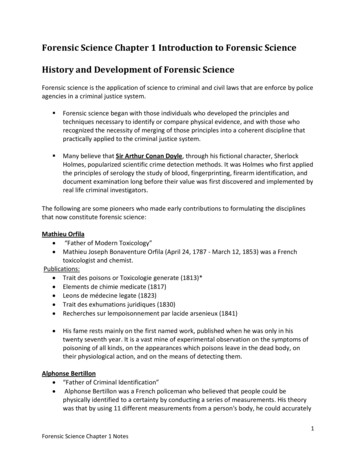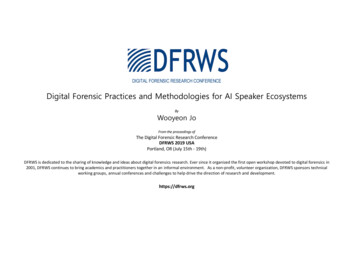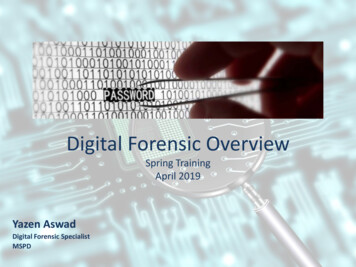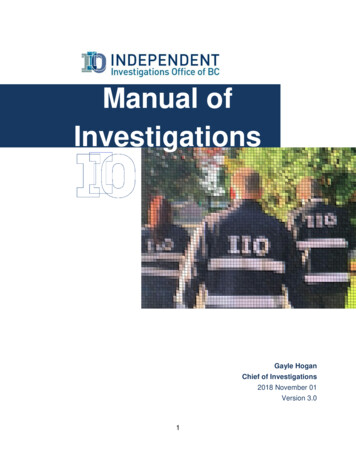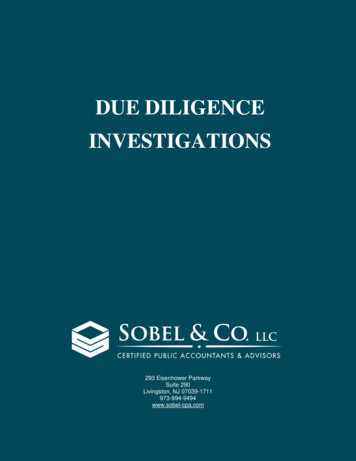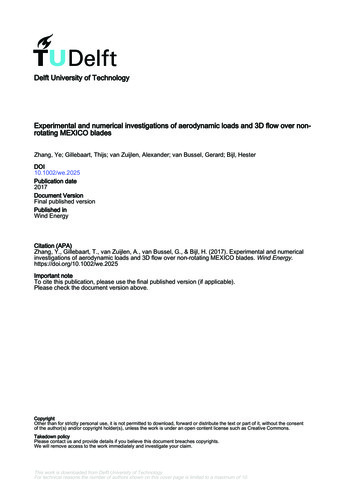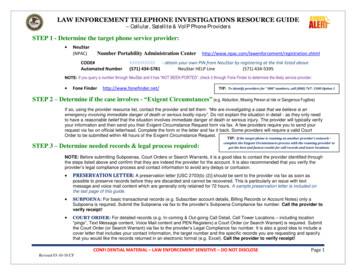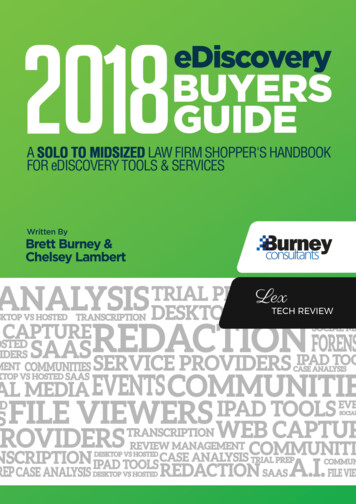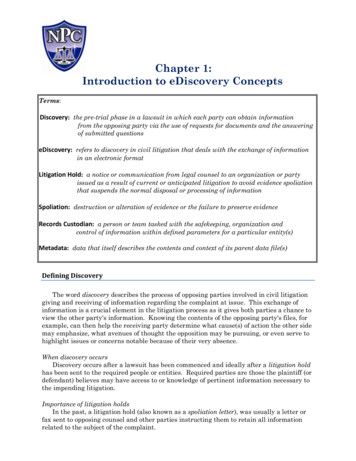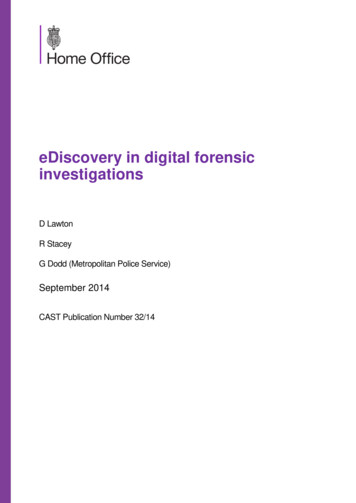
Transcription
eDiscovery in digital forensicinvestigationsD LawtonR StaceyG Dodd (Metropolitan Police Service)September 2014CAST Publication Number 32/14
eDiscovery in digital forensic investigations
Contents1Summary . 12Introduction . 33Overview of eDiscovery . 43.1 What is eDiscovery? . 43.2 How does it work? . 43.3 eDiscovery in context . 63.4 Electronic Discovery Reference Model . 73.5 eDiscovery summary . 94Digital investigations and eDiscovery . 104.1 What is a digital investigation? . 104.2 Stages in gathering digital information . 104.3 Common ground with eDiscovery . 114.4 Digital investigation summary . 135Assessment of eDiscovery options . 145.1 Types of eDiscovery tool . 145.2 Digital investigation requirements for eDiscovery . 155.3 Significant gaps in functionality . 225.4 Assessment summary . 236eDiscovery in practice . 246.1 What opportunities does eDiscovery offer? . 246.2 Implications of adopting eDiscovery . 286.3 eDiscovery in practice summary . 327Conclusions . 338Glossary . 34Appendix A.Overview of assessment . 37Appendix B.Operational requirements . 38eDiscovery in digital forensic investigations
1 SummaryDigital information, such as that found on computers, mobile devices and storage media can berelevant in the investigation of a wide variety of crimes including the most serious. A variety ofenforcement agencies are responsible for investigating these crimes and securing theprosecution of suspects. However, the widespread uptake of sophisticated mobile devices,coupled with the affordability of storage has resulted in huge growth in the volume of digitalinformation being created and stored.Conventional law enforcement approaches rely on digital forensic examiners interrogatingseized devices and providing their findings to an investigator. Further avenues are then typicallyidentified by the investigator and the examiner re-examines the data in light of this newinformation. Both the examiner and investigator have relevant skills and knowledge to progressthe investigation but they are frequently applied independently in a protracted, to-and-froprocess.Given the proliferation of digital data, it is no surprise that the challenges brought about by largedata volumes are also of relevance to other professions. Corporate lawsuits are a naturalparallel, where the prohibitive cost of searching and reviewing substantial company archiveshas driven the need for software tools to be developed. The requirement for such tools hascome from both the defence and prosecution as the cost of data review is inevitably a point ofcontention. The use of tools to facilitate this electronic discovery process has become anaccepted approach to managing the cost of lawsuits and the market for these ‘eDiscovery’ toolswas estimated at 1.8 billion in 2014 and is expected to grow to 3.1 billion by 20181(approximately 1.1 billion and 1.9 billion respectively).The eDiscovery approach would appear to be applicable to the world of digital investigationswhere digital evidence from a number of devices or systems needs to be sifted, interpreted andacted upon in a rapid manner.In conjunction with the Metropolitan Police Service (MPS), the Centre for Applied Science andTechnology (CAST) recently conducted an assessment of commercial products offering aneDiscovery approach to reviewing large volumes of data. The assessment revealed someinteresting differences between the way that eDiscovery tools approach an investigation and thestandard workflow in a criminal investigation involving digital evidence.On the basis of this limited assessment, an ideal tool to support the needs of both the technicaland investigative elements of digital investigations does not appear to exist. However, the toolsassessed did meet many of the key requirements and could be a significant part of a combinedsolution. In addition, development of the tools has continued since the assessment and isbringing helpful improvements and new features to the market.There are examples of large law enforcement and regulatory bodies in the UK using eDiscoverytechniques as part of their investigations. There are a wide range of tools available and although11Magic Quadrant for E-Discovery Software, Gartner, 2014.eDiscovery in digital forensic investigations
some will be beyond the budget of all but the largest units, more moderately priced tools, andfree tools in some situations, are available to deliver some of the benefits of eDiscovery to awider audience.This document serves as an introduction to the area of eDiscovery, a survey of typicalfunctionality available and a guide to options for introducing eDiscovery into wider use incriminal investigations.2eDiscovery in digital forensic investigations
2 IntroductionDigital information, such as that found on computers, mobile devices and storage media can berelevant in the investigation of a wide variety of crimes including the most serious. Policing isresponsible for investigating these crimes and securing the prosecution of suspects. However,the widespread uptake of sophisticated mobile devices, coupled with the affordability of storagehas resulted in huge growth in the volume of digital information being created and stored.Working practices are struggling to keep pace with this trend. The historical practice ofexamining every exhibit in detail requires considerable time and, with limited ability to directmore resources at the task, either exhibits have to wait to be examined or the amount of workperformed on each exhibit must be rationed.The extraction of digital information from devices is a technical task that requires appropriatetools, training and experience if it is to be performed correctly. However, the examinerperforming the task may not be fully aware of the details of the investigation so their work needsto be steered by information from the investigating team. This division of skills and knowledgebetween the examiner and investigator can result in an inefficient process, lengthening theinvestigative process. Giving investigators rapid access to the digital information in a form thatthey can understand and work with has the potential to significantly enhance an investigation.CAST believes that there are useful lessons to be learnt from the way the legal profession hasdealt with the increasing quantity of electronically stored corporate information. This field istermed, within the legal profession, as electronic discovery or eDiscovery.In conjunction with the Metropolitan Police Service (MPS), CAST recently conducted anassessment of commercial products offering an eDiscovery approach to reviewing largevolumes of data. The assessment revealed some interesting differences between the way thateDiscovery tools approach an investigation and the standard workflow in a criminal investigationinvolving digital evidence.This report does not focus on the detailed performance of a few tools but on the ways in whichthe eDiscovery approach can assist the world of digital forensics and investigations.Section 3 contains an introduction to the area of eDiscovery including how it developed,examples of its use and efforts to standardise the process in the form of the widely acceptedElectronic Discovery Reference Model (EDRM).The following section provides a brief overview of digital investigations with a focus on digitalforensics and then looks at the common ground between this area and eDiscovery.The general lessons learnt from the assessment with the MPS are summarised in section 5before examples of ways of integrating eDiscovery techniques into a digital investigationworkflow are outlined in section 6.Section 1 concludes this report and is followed by a brief glossary which explains commonterms in their digital investigation or eDiscovery context.3eDiscovery in digital forensic investigations
3 Overview of eDiscovery3.1What is eDiscovery?With the world’s increasing reliance on digital media and the decreasing cost of data storage,many organisations have accumulated an extensive digital archive, storing far more data thanprevious paper-based systems. In 2003 it was estimated that 93% of documents are createdelectronically of which over 70% are never converted into hard copy2.Trying to retrieve information from this digital archive in a systematic way, for example inresponse to a Freedom of Information request or a legal proceeding, can be time-consumingand so a method of finding and reviewing potentially relevant material is required.This is not a new problem for large organisations. Taking a step back, when companies’ recordswere largely paper-based, responding to a disclosure request would have involved the manualreview of large volumes of paper records. Relevant material would be duplicated and thendelivered to the party requesting the information. For a large case, it could be more efficient toscan the paper records and deliver them to the requestor electronically. In many cases, it wasmore efficient to pay for all the possibly relevant documents to be scanned and significantkeywords listed, use the keywords to highlight potentially relevant documents, review thepotentially relevant ones and then pass on the final set of documents electronically. From theseinitial steps, electronic discovery has grown to a billion-dollar industry.Electronic discovery, or eDiscovery as it is termed in this report, is a process in which electronicdata is sought, located, secured, and searched with the intent of using it as evidence in a legalcase.The processes within eDiscovery are relatively straightforward but their application can requiresubstantial technical solutions due in the main to the quantity of data being stored andprocessed. Functions that are taken for granted within eDiscovery such as keyword searchingand distributed review are the basics around which a whole industry has grown, developing andrefining eDiscovery tools for both legal and investigative professionals.3.2How does it work?Once potentially relevant sources of information have been collected, the data is extracted,indexed and placed into a database within the chosen eDiscovery tool. Some tools refer to thedata in terms of matters, a legal term for discrete causes or claims to be resolved.The data can be initially reviewed to remove irrelevant documents and so reduce the volume ofdata. Two typical methods employed by eDiscovery tools to reduce the overall data volume areremoving duplicate documents and known files. A side effect of modern electroniccommunication is the frequency with which documents are duplicated, an email that is ‘cc’d’ for24Computer Technology Review, Sharon Isaacson, March 2003.eDiscovery in digital forensic investigations
example. This can be of assistance when the original source has been lost; however, suchduplication also adds to the amount of data recovered as part of an investigation. eDiscoverytools identify duplicate documents via hashing and some can also detect near-duplicates (suchas different drafts of a document). This process is referred to as de-duplication or nearde-duplication. Some files are straightforward to hash but collections of files such as emailarchives can be trickier where vendors use different combinations of email content andmetadata to produce a vendor-specific hash value for each email and to identify conversationthreads.The identification of known files is performed by comparison to white lists containing the hashesof common files that will have no relevance to an investigation. This is often referred to asde-NISTing as NIST (National Institute of Standards and Technology) produce the NationalSoftware Reference Library (NSRL) of hashes of standard files from operating systems andcommon applications.The tools identify duplicates within the data when it is first imported. This has an initial time costbut enables virtually instant de-duplication when the data is interrogated during the subsequentinvestigation. Note, you would not always want to de-duplicate so the option is normallypresented to the user of the tool.The data then passes through multiple stages of manual review in order to highlight items ofinterest for further examination. This may be to determine if the item is truly relevant or, as aseparate issue to check for privileged material. This sort of material comes from various sourcesincluding legal, medical and journalistic. This could arise in an investigation where a lawyer maybe advising some clients legitimately but also providing a criminal service to others. Redactionmay be used in order to shield the particulars of either individuals or companies who do not formpart of the investigation itself but whose details appear in the raw data.The electronic data under scrutiny in any investigation will invariably contain metadata includinginformation such as time stamps and details of the document’s author. In some cases morespecific metadata such as geographical location and the make and model of camera used tocreate a photograph may be present; all information that may provide valuable insight for aninvestigation or help further reduce the volume of data to be considered.Another frequently used method of data sifting is keyword searching. Depending upon the toolin use, such searches can range from single word searches through to more complex Booleanlogic searches where multiple searches are combined by the use of AND, OR and NOTfunctions, for example searches for ‘Fraud’ AND ‘UK’ NOT ‘VAT’. Keyword searches need someconsideration as they do not discriminate between words that are spelt the same but havedifferent meanings, for example ‘Bow’ can be on a present, the front of a ship, used to play astringed instrument or a district of London amongst other definitions.As eDiscovery tools have developed, so has the complexity of their search functionality.Concept searching moves on from the multiple meaning problem of keyword searching to try tounderstand the concept being conveyed rather than a specific set of letters. For example, akeyword search for ‘gun’ might return both gun and guns whereas a concept search for thesame single word could potentially return documents that contained terms such as ‘shooter’,‘piece’ or ‘sawn-off’. Predictive coding is a feature of a limited number of eDiscovery tools wheredocuments that have been manually reviewed are automatically analysed to identify keydistinguishing features and then the rest of the material is searched to identify similardocuments.A possible feature of advanced search methods is detecting emotion. The advertising industryrelies heavily on such algorithms to deduce whether a brand is currently in favour with5eDiscovery in digital forensic investigations
consumers by trawling online comment. At least one tool is currently available which offers thisfunctionality but it has not been widely adopted yet.The advanced searching capabilities some of the tools offer can come with a significantprocessing requirement and have not been widely tested in court yet. As such, they mayactually present an extra cost to the process as they consume time or hardware resources andmay be challenged.Throughout the eDiscovery process, the implementation of various searches ultimately reducesthe volume of material and so reduces the cost and time of an investigation. The goal ofeDiscovery is the production of a concise data set related to a line of enquiry. Extending this toapplication in a criminal investigation, the aim should be for those documents to not just berelevant but for the process to assist in building a forensically sound case.3.3eDiscovery in contextThe case of Zubulake v. UBS Warburg is frequently referenced with regard to eDiscovery and isconsidered a landmark eDiscovery case in the United States. The case centred on anemployee’s claim of sex discrimination against their employer. As the case developed, “alldocuments concerning any communication by or between UBS employees and the plaintiff”were requested. In response UBS produced approximately 100 emails claiming that this was theextent of the data held. However, it was discovered that back-up tapes had not been searched.At this point the case turned from a conventional discrimination dispute into a test of disclosurewhich established responsibilities on the various parties involved and resulted in one of thehighest awards to an individual employee in history.The court stated that “a party or anticipated party must retain all relevant documents (but notmultiple identical copies) in existence at the time the duty to preserve attaches, and any relevantdocuments created thereafter,” and outlined three groups of interested parties who shouldmaintain Electronically Stored Information (ESI). Primary players: Those who are likely to have discoverable information that thedisclosing party may use to support its claims or defences.Assistants to primary players: Those who prepare documents for those individuals thatcan be readily identified.Witnesses: The duty also extends to information that is relevant to the claims or defencesof any party, or which is relevant to the subject matter involved in the action.The jury heard testimony of the missing data and returned a verdict for 29.3 million ( 17.6million), which included 20.2 million ( 12.1 million) in disciplinary damages.An illustration of the scale of damages that can be involved when two corporations go to courtand fail to meet their disclosure responsibilities is provided by the case of Coleman (Parent)Holdings, Inc. v. Morgan Stanley & Co. Multiple errors in Morgan Stanley’s attempts to produceemail archives resulted in a claim for 2 billion ( 1.2 billion) in punitive damages on top of theoriginal
1 Magic Quadrant for E-Discovery Software, Gartner, 2014. 2 eDiscovery in digital forensic investigations some will be beyond the budget of all but the largest units, more moderately priced tools, and
